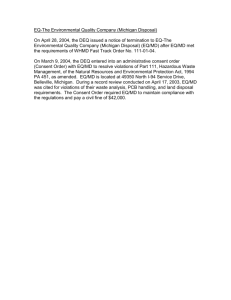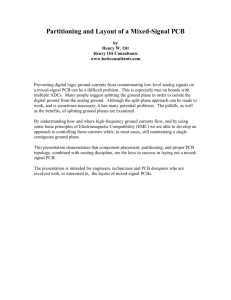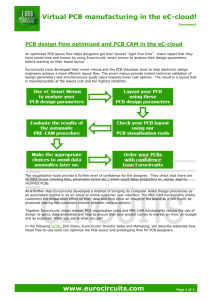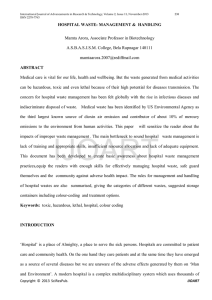Enforcement of Waste Management Rules
advertisement
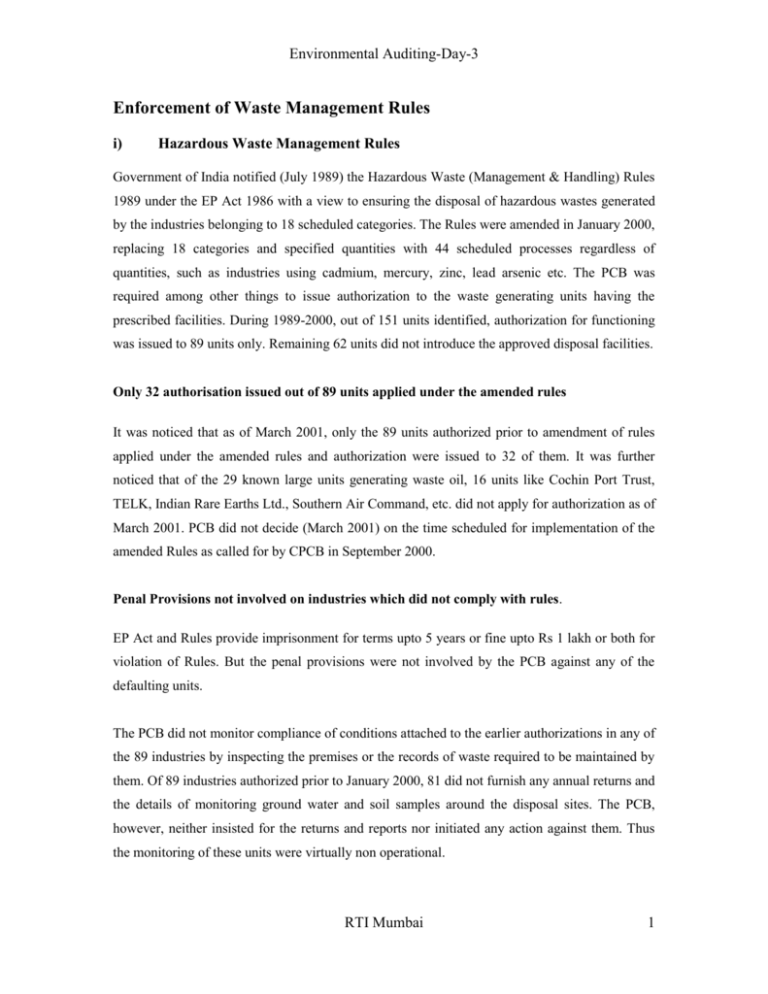
Environmental Auditing-Day-3 Enforcement of Waste Management Rules i) Hazardous Waste Management Rules Government of India notified (July 1989) the Hazardous Waste (Management & Handling) Rules 1989 under the EP Act 1986 with a view to ensuring the disposal of hazardous wastes generated by the industries belonging to 18 scheduled categories. The Rules were amended in January 2000, replacing 18 categories and specified quantities with 44 scheduled processes regardless of quantities, such as industries using cadmium, mercury, zinc, lead arsenic etc. The PCB was required among other things to issue authorization to the waste generating units having the prescribed facilities. During 1989-2000, out of 151 units identified, authorization for functioning was issued to 89 units only. Remaining 62 units did not introduce the approved disposal facilities. Only 32 authorisation issued out of 89 units applied under the amended rules It was noticed that as of March 2001, only the 89 units authorized prior to amendment of rules applied under the amended rules and authorization were issued to 32 of them. It was further noticed that of the 29 known large units generating waste oil, 16 units like Cochin Port Trust, TELK, Indian Rare Earths Ltd., Southern Air Command, etc. did not apply for authorization as of March 2001. PCB did not decide (March 2001) on the time scheduled for implementation of the amended Rules as called for by CPCB in September 2000. Penal Provisions not involved on industries which did not comply with rules. EP Act and Rules provide imprisonment for terms upto 5 years or fine upto Rs 1 lakh or both for violation of Rules. But the penal provisions were not involved by the PCB against any of the defaulting units. The PCB did not monitor compliance of conditions attached to the earlier authorizations in any of the 89 industries by inspecting the premises or the records of waste required to be maintained by them. Of 89 industries authorized prior to January 2000, 81 did not furnish any annual returns and the details of monitoring ground water and soil samples around the disposal sites. The PCB, however, neither insisted for the returns and reports nor initiated any action against them. Thus the monitoring of these units were virtually non operational. RTI Mumbai 1 Environmental Auditing-Day-3 ii) Bio-Medical Waste Rules Out of 1668 hospitals identified, only 106 applied for authorization and none was issued authorization. a) Ineffective monitoring of waste generating sources The Bio-Medical Waste Rules 1998 came into effect from July 1998 covering the whole State, for ensuring that Bio-Medical waste was handled without any adverse effect on human health and environment. According to the Rules the State Government was to appoint a prescribed authority within one month (August 1998) for granting authorization and to constitute an Advisory Committee which should advise the Government and the prescribed authority. Government specified (October 1999) PCB as the prescribed authority under the Rules. According to the schedule prescribed in the Rules, hospitals with bed strength of 200 and above should have introduced facilities such as incineration, autoclaving etc. for disposal of bio-medical wastes by December 1999. PCB collected a list of 1668 hospitals including 81 having a bed strength of 200 and above and issued notices to them in June 2000. However, 106 applications including 36 hospitals with a bed strength of 200 were received for authorization as of March 2001. None of the 106 hospitals has been issued authorization so far (May 2001) for want of prescribed facilities for waste disposal. In the absence of adequate waste disposal facilities, the bio-medical and solid waste in the above hospitals were partly burned in the open and the rest was dumped in the open causing hazards to the public and environment till the local bodies removed it to their trenching or dumping yards. However, identification of bio-medical waste generating sources had been confined to hospitals and nursing homes only and other sources like clinical laboratories, veterinary institutions, animal houses etc. were left out. Non-identification of these sources came to the notice of the PCB only at the instance of audit. Further action taken in this regard had not been intimated by the PCB as of October 2001. RTI Mumbai 2



